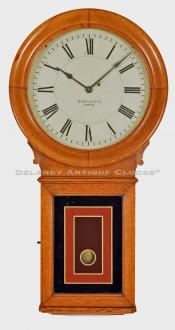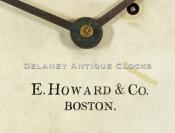E. Howard & Co. Model No. 70-16 wall clock. The middle size. Boston, MA. XX-25.
The E. Howard & Company offered five different sizes of the Model 70 form. This example is the middle size and is seldom seen. This clock displays the time on a dial that measures a full 16 inches in diameter. The case is approximately 42 inches long.
The Model 70 was successfully sold. It was used extensively in the Boston Public School System, in the various Boroughs of Greater New York, and in many other places as the Standard School Clock. It is reported that the United States Government specified it as the "Standard for all Public Buildings." One would also see this model in use in many of the Nations railroad stations. These included: The Elevated Railroad Stations of New York City, The Pennsylvania Railroad Company, The Central Railroad of New Jersey, the West Shore Railroad of Boston & Albany, and nearly all Railroad Companies throughout the United States, Mexico, and Canada.
This is a larger size, Model 70. The case measures 42 inches in overall length. The case is constructed of oak. Quartersawn boards are used as the sides of the case. An older original finish highlights the grain and color of the wood. Providing access to the dial is the shaped and hinged dial bezel. This is fitted with glass.
The large diameter dial has the advantage of being large enough to be easily read across the distance of most rooms. Compared to the common 12-inch dial examples, we have had very few opportunities to purchase this model. This original painted zinc dial features a closed minute ring and Large Roman-style hour numerals. The Clockmakers' name is located above the hour of VI in block lettering. It reads, "E. Howard & Co. / BOSTON." Spade-shaped hands display the time. Behind the dial is the weight-driven movement.
The brass, eight-day, weight-driven clock mechanism is of excellent quality. The Howard Clock Company guaranteed this clock not to vary in time more than one minute a month. The movement is secured to the case through the backboard with a single screw into the backplate. Four turned pillars support the two rectangular-shaped brass plates. The Maker's name and model number "4" are die-stamped into the front plate. Hardened steel shafts support the polished steel pinions and the brass gearing. The escapement is a recoil design. The pendulum hangs from a bridge mounted on the front of the movement. A painted wooden rod supports a zinc bob that is covered in brass. A series of decorative concentric rings are lightly engraved into the brass surface. This pendulum bob swings in front of a painted wooden weight board. The Clockmaker's setup label is pasted to the back of the door frame. This lower door is fitted with paint-decorated glass. The paint is applied from the back in the traditional Howard colors of black, red, and gold.
This fine example was made circa 1890. It has the following approximate dimensions in inches. 46 long. 20.5 Wide. 5.5 Deep.
Inventory number XX-25.
The E. Howard & Company succeeded the Howard & Davis firm in 1857. The Howard & Davis firm was comprised of Edward Howard and David Porter Davis and was established in 1842 in Roxbury, Massachusetts. Both men had just completed their clock apprenticeship under the guidance of Aaron Willard Jr in Boston. The Howard & Davis firm made high-grade clocks, precision balances, sewing machines, fire engines, and watches. After the dissolution of Howard & Davis, Edward Howard became Boston's leading manufacturer of weight-driven residential and commercial clocks. The firm also made a large number of tower clocks and watchman and salve clock systems. These sold well in the last quarter of the 1800s.
It has been said that the E. Howard Clock company never made an inexpensive clock, and everything they made was of very good quality. As a result, Howard clocks have become very collectible and are prized by their owners. Today, the E. Howard name enjoys outstanding name recognition.
For a more in-depth reading of Edward Howard and his various businesses, please read "Willard's Patent Time Pieces," written by Paul Foley.
















